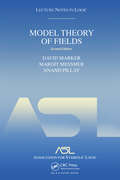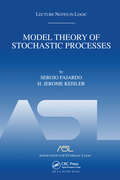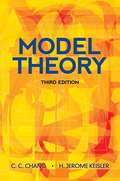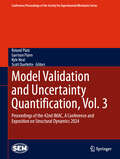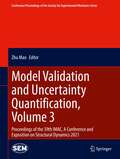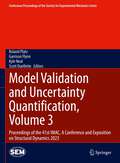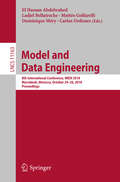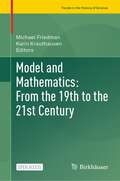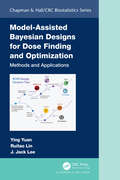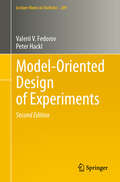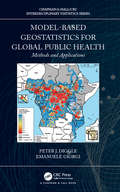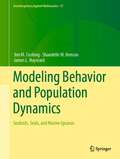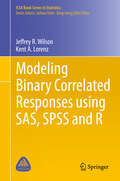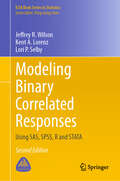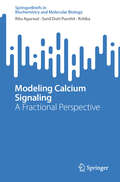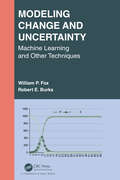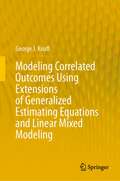- Table View
- List View
Model Theory in Algebra, Analysis and Arithmetic
by Anand Pillay Lou Dries Jochen Koenigsmann H. Dugald Macpherson Carlo Toffalori Alex J. WilkiePresenting recent developments and applications, the book focuses on four main topics in current model theory: 1) the model theory of valued fields; 2) undecidability in arithmetic; 3) NIP theories; and 4) the model theory of real and complex exponentiation. Young researchers in model theory will particularly benefit from the book, as will more senior researchers in other branches of mathematics.
Model Theory of Fields: Lecture Notes in Logic 5, Second Edition
by David Marker Margit Messmer Anand PillayThe model theory of fields is a fascinating subject stretching from Tarski's work on the decidability of the theories of the real and complex fields to Hrushovksi's recent proof of the Mordell-Lang conjecture for function fields. This volume provides an insightful introduction to this active area, concentrating on connections to stability theory.
Model Theory of Stochastic Processes: Lecture Notes in Logic 14
by Sergio Fajardo H. Jerome KeislerThis book presents new research in probability theory using ideas from mathematical logic. It is a general study of stochastic processes on adapted probability spaces, employing the concept of similarity of stochastic processes based on the notion of adapted distribution. The authors use ideas from model theory and methods from nonstandard analysis
Model Theory: Third Edition (Dover Books on Mathematics #58)
by H. Jerome Keisler C. C. ChangModel theory deals with a branch of mathematical logic showing connections between a formal language and its interpretations or models. This is the first and most successful textbook in logical model theory. Extensively updated and corrected in 1990 to accommodate developments in model theoretic methods -- including classification theory and nonstandard analysis -- the third edition added entirely new sections, exercises, and references. Each chapter introduces an individual method and discusses specific applications. Basic methods of constructing models include constants, elementary chains, Skolem functions, indiscernibles, ultraproducts, and special models. The final chapters present more advanced topics that feature a combination of several methods. This classic treatment covers most aspects of first-order model theory and many of its applications to algebra and set theory.
Model Validation and Uncertainty Quantification, Vol. 3: Proceedings of the 42nd IMAC, A Conference and Exposition on Structural Dynamics 2024 (Conference Proceedings of the Society for Experimental Mechanics Series)
by Roland Platz Garrison Flynn Kyle Neal Scott OuelletteModel Validation and Uncertainty Quantification, Volume 3: Proceedings of the 42nd IMAC, A Conference and Exposition on Structural Dynamics, 2024, the third volume of ten from the Conference brings together contributions to this important area of research and engineering. The collection presents early findings and case studies on fundamental and applied aspects of Model Validation and Uncertainty Quantification, including papers on: Uncertainty Quantification in Dynamics Fusion of Test and Analysis Model Form Uncertainty: Round Robin Challenge UQVI (Uncertainty Quantification in Vibration Isolation) Recursive Bayesian System Identification Virtual Sensing & Realtime Monitoring Surrogate Modeling and Reduced Order Models
Model Validation and Uncertainty Quantification, Volume 3: Proceedings of the 36th IMAC, A Conference and Exposition on Structural Dynamics 2018 (Conference Proceedings of the Society for Experimental Mechanics Series)
by Robert BarthorpeModel Validation and Uncertainty Quantification, Volume 3: Proceedings of the 36th IMAC, A Conference and Exposition on Structural Dynamics, 2018, the third volume of nine from the Conference brings together contributions to this important area of research and engineering. The collection presents early findings and case studies on fundamental and applied aspects of Model Validation and Uncertainty Quantification, including papers on:Uncertainty Quantification in Material ModelsUncertainty Propagation in Structural DynamicsPractical Applications of MVUQAdvances in Model Validation & Uncertainty Quantification: Model UpdatingModel Validation & Uncertainty Quantification: Industrial ApplicationsControlling UncertaintyUncertainty in Early Stage DesignModeling of Musical InstrumentsOverview of Model Validation and Uncertainty
Model Validation and Uncertainty Quantification, Volume 3: Proceedings of the 39th IMAC, A Conference and Exposition on Structural Dynamics 2021 (Conference Proceedings of the Society for Experimental Mechanics Series)
by Zhu MaoModel Validation and Uncertainty Quantification, Volume 3: Proceedings of the 39th IMAC, A Conference and Exposition on Structural Dynamics, 2021, the third volume of nine from the Conference brings together contributions to this important area of research and engineering. The collection presents early findings and case studies on fundamental and applied aspects of Model Validation and Uncertainty Quantification, including papers on:Inverse Problems and Uncertainty QuantificationControlling UncertaintyValidation of Models for Operating EnvironmentsModel Validation & Uncertainty Quantification: Decision MakingUncertainty Quantification in Structural DynamicsUncertainty in Early Stage DesignComputational and Uncertainty Quantification Tools
Model Validation and Uncertainty Quantification, Volume 3: Proceedings of the 41st IMAC, A Conference and Exposition on Structural Dynamics 2023 (Conference Proceedings of the Society for Experimental Mechanics Series)
by Roland Platz Garrison Flynn Kyle Neal Scott OuelletteModel Validation and Uncertainty Quantification, Volume 3: Proceedings of the 41st IMAC, A Conference and Exposition on Structural Dynamics, 2023, the third volume of ten from the Conference brings together contributions to this important area of research and engineering. The collection presents early findings and case studies on fundamental and applied aspects of Model Validation and Uncertainty Quantification, including papers on:Introduction of Uncertainty QuantificationUncertainty Quantification in DynamicsModel Form Uncertainty and Selection incl. Round Robin ChallengeSensor and Information FusionVirtual Sensing, Certification, and Real-Time MonitoringSurrogate Modeling
Model and Data Engineering: 13th International Conference, MEDI 2024, Naples, Italy, November 18–20, 2024, Proceedings (Lecture Notes in Computer Science #15590)
by Ladjel Bellatreche Elio Masciari Carlos Ordonez Giancarlo SperlìThis book constitutes the refereed proceedings of the 13th International Conference onModel and Data Engineering, MEDI 2024, held in Naples, Italy, during November 18–20, 2024. The 7 full papers and 11 short papers were carefully peer reviewed and selected from 45 submissions.They were organized in topical sections as follows: AI-Enabled Systems; Security and Privacy; Query Processing; Prediction; Conceptual Issues; and Applications.
Model and Data Engineering: 8th International Conference, MEDI 2018, Marrakesh, Morocco, October 24–26, 2018, Proceedings (Lecture Notes in Computer Science #11163)
by Ladjel Bellatreche Carlos Ordonez El Hassan Abdelwahed Mattéo Golfarelli Dominique MéryThis book constitutes the refereed proceedings of the 8h International Conference on Model and Data Engineering, MEDI 2018, held in Marrakesh, Morocco, in October 2018.The 23 full papers and 4 short papers presented together with 2 invited talks were carefully reviewed and selected from 86 submissions. The papers covered the recent and relevant topics in the areas of databases; ontology and model-driven engineering; data fusion, classsification and learning; communication and information technologies; safety and security; algorithms and text processing; and specification, verification and validation.
Model and Mathematics: From the 19th to the 21st Century (Trends in the History of Science)
by Michael Friedman Karin KrauthausenThis open access book collects the historical and medial perspectives of a systematic and epistemological analysis of the complicated, multifaceted relationship between model and mathematics, ranging from, for example, the physical mathematical models of the 19th century to the simulation and digital modelling of the 21st century. The aim of this anthology is to showcase the status of the mathematical model between abstraction and realization, presentation and representation, what is modeled and what models.This book is open access under a CC BY 4.0 license.
Model-Assisted Bayesian Designs for Dose Finding and Optimization: Methods and Applications (Chapman & Hall/CRC Biostatistics Series)
by Ying Yuan J. Jack Lee Ruitao LinBayesian adaptive designs provide a critical approach to improve the efficiency and success of drug development that has been embraced by the US Food and Drug Administration (FDA). This is particularly important for early phase trials as they form the basis for the development and success of subsequent phase II and III trials. The objective of this book is to describe the state-of-the-art model-assisted designs to facilitate and accelerate the use of novel adaptive designs for early phase clinical trials. Model-assisted designs possess avant-garde features where superiority meets simplicity. Model-assisted designs enjoy exceptional performance comparable to more complicated model-based adaptive designs, yet their decision rules often can be pre-tabulated and included in the protocol—making implementation as simple as conventional algorithm-based designs. An example is the Bayesian optimal interval (BOIN) design, the first dose-finding design to receive the fit-for-purpose designation from the FDA. This designation underscores the regulatory agency's support of the use of the novel adaptive design to improve drug development. Features Represents the first book to provide comprehensive coverage of model-assisted designs for various types of dose-finding and optimization clinical trials Describes the up-to-date theory and practice for model-assisted designs Presents many practical challenges, issues, and solutions arising from early-phase clinical trials Illustrates with many real trial applications Offers numerous tips and guidance on designing dose finding and optimization trials Provides step-by-step illustrations of using software to design trials Develops a companion website (www.trialdesign.org) to provide freely available, easy-to-use software to assist learning and implementing model-assisted designs Written by internationally recognized research leaders who pioneered model-assisted designs from the University of Texas MD Anderson Cancer Center, this book shows how model-assisted designs can greatly improve the efficiency and simplify the design, conduct, and optimization of early-phase dose-finding trials. It should therefore be a very useful practical reference for biostatisticians, clinicians working in clinical trials, and drug regulatory professionals, as well as graduate students of biostatistics. Novel model-assisted designs showcase the new KISS principle: Keep it simple and smart!
Model-Based Clustering, Classification, and Density Estimation Using mclust in R (Chapman & Hall/CRC The R Series)
by Chris Fraley Luca Scrucca T. Brendan Murphy Raftery Adrian E.Model-Based Clustering, Classification, and Denisty Estimation Using mclust in R Model-based clustering and classification methods provide a systematic statistical approach to clustering, classification, and density estimation via mixture modeling. The model-based framework allows the problems of choosing or developing an appropriate clustering or classification method to be understood within the context of statistical modeling. The mclust package for the statistical environment R is a widely adopted platform implementing these model-based strategies. The package includes both summary and visual functionality, complementing procedures for estimating and choosing models. Key features of the book: An introduction to the model-based approach and the mclust R package A detailed description of mclust and the underlying modeling strategies An extensive set of examples, color plots, and figures along with the R code for reproducing them Supported by a companion website, including the R code to reproduce the examples and figures presented in the book, errata, and other supplementary material Model-Based Clustering, Classification, and Density Estimation Using mclust in R is accessible to quantitatively trained students and researchers with a basic understanding of statistical methods, including inference and computing. In addition to serving as a reference manual for mclust, the book will be particularly useful to those wishing to employ these model-based techniques in research or applications in statistics, data science, clinical research, social science, and many other disciplines.
Model-Free Prediction and Regression
by Dimitris N. PolitisThe Model-Free Prediction Principle expounded upon in this monograph is based on the simple notion of transforming a complex dataset to one that is easier to work with, e. g. , i. i. d. or Gaussian. As such, it restores the emphasis on observable quantities, i. e. , current and future data, as opposed to unobservable model parameters and estimates thereof, and yields optimal predictors in diverse settings such as regression and time series. Furthermore, the Model-Free Bootstrap takes us beyond point prediction in order to construct frequentist prediction intervals without resort to unrealistic assumptions such as normality. Prediction has been traditionally approached via a model-based paradigm, i. e. , (a) fit a model to the data at hand, and (b) use the fitted model to extrapolate/predict future data. Due to both mathematical and computational constraints, 20th century statistical practice focused mostly on parametric models. Fortunately, with the advent of widely accessible powerful computing in the late 1970s, computer-intensive methods such as the bootstrap and cross-validation freed practitioners from the limitations of parametric models, and paved the way towards the `big data' era of the 21st century. Nonetheless, there is a further step one may take, i. e. , going beyond even nonparametric models; this is where the Model-Free Prediction Principle is useful. Interestingly, being able to predict a response variable Y associated with a regressor variable X taking on any possible value seems to inadvertently also achieve the main goal of modeling, i. e. , trying to describe how Y depends on X. Hence, as prediction can be treated as a by-product of model-fitting, key estimation problems can be addressed as a by-product of being able to perform prediction. In other words, a practitioner can use Model-Free Prediction ideas in order to additionally obtain point estimates and confidence intervals for relevant parameters leading to an alternative, transformation-based approach to statistical inference.
Model-Oriented Design of Experiments (Lecture Notes in Statistics #209)
by Valerii V. Fedorov Peter HacklThis book presents the basic ideas of statistical methods in the design of optimal experiments. This new edition now includes sections on design techniques based on the elemental Fisher information matrices (as opposed to Pearson information/moment matrices), allowing a seamless extension of the design techniques to inferential problems where the shape of distributions is essential for optimal design construction. Topics include designs for nonlinear models, models with random parameters and models with correlated observations, designs for model discrimination and misspecified (contaminated) models, and designs in functional spaces. The authors avoid technical details, assuming a moderate background in calculus, matrix algebra, and statistics. In many places, however, suggestions are made as to how the ideas presented in this book can be extended and elaborated for use in real scientific research and practical engineering problems.
Model-based Geostatistics for Global Public Health: Methods and Applications (Chapman & Hall/CRC Interdisciplinary Statistics)
by Peter J. Diggle Emanuele GiorgiModel-based Geostatistics for Global Public Health: Methods and Applications provides an introductory account of model-based geostatistics, its implementation in open-source software and its application in public health research. In the public health problems that are the focus of this book, the authors describe and explain the pattern of spatial variation in a health outcome or exposure measurement of interest. Model-based geostatistics uses explicit probability models and established principles of statistical inference to address questions of this kind. <P><P>Features: <li>Presents state-of-the-art methods in model-based geostatistics. <li>Discusses the application these methods some of the most challenging global public health problems including disease mapping, exposure mapping and environmental epidemiology. <li>Describes exploratory methods for analysing geostatistical data, including: diagnostic checking of residuals standard linear and generalized linear models; variogram analysis; Gaussian process models and geostatistical design issues. <li>Includes a range of more complex geostatistical problems where research is ongoing. <li>All of the results in the book are reproducible using publicly available R code and data-sets, as well as a dedicated R package. <li>This book has been written to be accessible not only to statisticians but also to students and researchers in the public health sciences. <P><P>The Authors <P><P>Peter Diggle is Distinguished University Professor of Statistics in the Faculty of Health and Medicine, Lancaster University. He also holds honorary positions at the Johns Hopkins University School of Public Health, Columbia University International Research Institute for Climate and Society, and Yale University School of Public Health. His research involves the development of statistical methods for analyzing spatial and longitudinal data and their applications in the biomedical and health sciences. <P><P>Dr Emanuele Giorgi is a Lecturer in Biostatistics and member of the CHICAS research group at Lancaster University, where he formerly obtained a PhD in Statistics and Epidemiology in 2015. His research interests involve the development of novel geostatistical methods for disease mapping, with a special focus on malaria and other tropical diseases. In 2018, Dr Giorgi was awarded the Royal Statistical Society Research Prize "for outstanding published contribution at the interface of statistics and epidemiology." He is also the lead developer of PrevMap, an R package where all the methodology found in this book has been implemented.
Model-free Hedging: A Martingale Optimal Transport Viewpoint (Chapman and Hall/CRC Financial Mathematics Series)
by Pierre Henry-LabordereModel-free Hedging: A Martingale Optimal Transport Viewpoint focuses on the computation of model-independent bounds for exotic options consistent with market prices of liquid instruments such as Vanilla options. The author gives an overview of Martingale Optimal Transport, highlighting the differences between the optimal transport and its martingale counterpart. This topic is then discussed in the context of mathematical finance.
Modeling Behavior and Population Dynamics: Seabirds, Seals, and Marine Iguanas (Interdisciplinary Applied Mathematics #57)
by Jim M. Cushing Shandelle M. Henson James L. HaywardThis monograph summarizes several decades of collaborations between ecologists and mathematicians, presenting novel applications in biological modeling. The authors are among the first researchers to pioneer the use of dynamical systems models to successfully describe and predict animal behavior in relation to environmental changes. The text highlights the biological and mathematical techniques used in the research, including three main components: 1) large data sets on natural populations in the field; 2) mathematical models rigorously tied to data, which describe, explain, and predict behavioral dynamics in relation to environmental variables; and 3) simplified, proof-of-concept models to probe dynamic mechanisms, suggest testable hypotheses, and allow study of the consequences of environmental change and evolving traits. It is a suitable text for field ecologists interested in the modeling procedures and conclusions addressed therein, as well as mathematicians interested in applications to population, ecological, and evolutionary dynamics.
Modeling Binary Correlated Responses using SAS, SPSS and R (ICSA Book Series in Statistics #9)
by Jeffrey R. Wilson Kent A. LorenzStatistical tools to analyze correlated binary data are spread out in the existing literature. This book makes these tools accessible to practitioners in a single volume. Chapters cover recently developed statistical tools and statistical packages that are tailored to analyzing correlated binary data. The authors showcase both traditional and new methods for application to health-related research. Data and computer programs will be publicly available in order for readers to replicate model development, but learning a new statistical language is not necessary with this book. The inclusion of code for R, SAS, and SPSS allows for easy implementation by readers. For readers interested in learning more about the languages, though, there are short tutorials in the appendix. Accompanying data sets are available for download through the book s website. Data analysis presented in each chapter will provide step-by-step instructions so these new methods can be readily applied to projects. Researchers and graduate students in Statistics, Epidemiology, and Public Health will find this book particularly useful.
Modeling Binary Correlated Responses: Using SAS, SPSS, R and STATA (ICSA Book Series in Statistics)
by Jeffrey R. Wilson Kent A. Lorenz Lori P. SelbyThis book is an updated edition of Modeling Binary Correlated Responses Using SAS, SPSS and R, and now it includes the use of STATA. It uses these Statistical tools to analyze correlated binary data, accessible to practitioners in a single volume. Chapters cover recently developed statistical tools and statistical packages, as well as showcase both traditional and new methods for application to health-related research. Data analysis presented in each chapter will provide step-by-step instructions so these new methods can be readily applied to projects. Short tutorials are in the appendix, for readers interested in learning more about the languages. Data and computer programs will be publicly available in order for readers to replicate model development, but learning a new statistical language is not necessary with this book. The inclusion of code for R, SAS, SPSS and STATA, allows for easy implementation by readers. Researchers and graduate students in Statistics, Epidemiology, and Public Health will find this book particularly useful.
Modeling Biomaterials (Nečas Center Series)
by Endre Süli Josef MálekThe investigation of the role of mechanical and mechano-chemical interactions in cellular processes and tissue development is a rapidly growing research field in the life sciences and in biomedical engineering. Quantitative understanding of this important area in the study of biological systems requires the development of adequate mathematical models for the simulation of the evolution of these systems in space and time. Since expertise in various fields is necessary, this calls for a multidisciplinary approach.This edited volume connects basic physical, biological, and physiological concepts to methods for the mathematical modeling of various materials by pursuing a multiscale approach, from subcellular to organ and system level. Written by active researchers, each chapter provides a detailed introduction to a given field, illustrates various approaches to creating models, and explores recent advances and future research perspectives. Topics covered include molecular dynamics simulations of lipid membranes, phenomenological continuum mechanics of tissue growth, and translational cardiovascular modeling. Modeling Biomaterials will be a valuable resource for both non-specialists and experienced researchers from various domains of science, such as applied mathematics, biophysics, computational physiology, and medicine.
Modeling Calcium Signaling: A Fractional Perspective (SpringerBriefs in Biochemistry and Molecular Biology)
by Sunil Dutt Purohit Ritu Agarwal KritikaThis book features chapters written by renowned scientists from various parts of the world, providing an up-to-date survey of submanifold theory, spanning diverse topics and applications. The book covers a wide range of topics such as Chen–Ricci inequalities in differential geometry, optimal inequalities for Casorati curvatures in quaternion geometry, conformal η-Ricci–Yamabe solitons, submersion on statistical metallic structure, solitons in f(R, T)-gravity, metric-affine geometry, generalized Wintgen inequalities, tangent bundles, and Lagrangian submanifolds. Moreover, the book showcases the latest findings on Pythagorean submanifolds and submanifolds of four-dimensional f-manifolds. The chapters in this book delve into numerous problems and conjectures on submanifolds, providing valuable insights for scientists, educators, and graduate students looking to stay updated with the latest developments in the field. With its comprehensive coverage and detailed explanations, this book is an essential resource for anyone interested in submanifold theory.
Modeling Change and Uncertainty: Machine Learning and Other Techniques (Textbooks in Mathematics)
by William P. Fox Robert E. BurksMathematical modeling is a powerful craft that requires practice. The more practice the better one will become in executing the art. The authors wrote this book to develop the craft of mathematical modeling and to foster a desire for lifelong learning, habits of mind and develop competent and confident problem solvers and decision makers for the 21st century. This book offers a problem-solving approach. The authors introduce a problem to help motivate the learning of a particular mathematical modeling topic. The problem provides the issue or what is needed to solve using an appropriate modeling technique. Then principles are applied to the problem and present the steps in obtaining an appropriate model to solve the problem. Modeling Change and Uncertainty: Covers both linear and nonlinear models of discrete dynamical systems. Introduces statistics and probability modeling. Introduces critical statistical concepts to handle univariate and multivariate data. Establishes a foundation in probability modeling. Uses ordinary differential equations (ODEs) to develop a more robust solution to problems. Uses linear programming and machine learning to support decision making. Introduces the reality of uncertainty and randomness that is all around us. Discusses the use of linear programing to solve common problems in modern industry. Discusses he power and limitations of simulations. Introduces the methods and formulas used in businesses and financial organizations. Introduces valuable techniques using Excel, MAPLE, and R. Mathematical modeling offers a framework for decision makers in all fields. This framework consists of four key components: the formulation process, the solution process, interpretation of the solution in the context of the actual problem, and sensitivity analysis. Modeling Change and Uncertainty will be of interest to mathematics departments offering advanced mathematical modeling courses focused on decision making or discrete mathematical modeling and by undergraduate, graduate students and practitioners looking for an opportunity to develop, practice, and apply the craft of mathematical modeling. Table of Contents 1. Perfect Partners: Combining Models of Change and Uncertainty with Technology2. Modeling Change: Discrete Dynamical Systems (DDS) and Modeling Systems of DDS3. Statistical and Probabilistic Models4. Modeling with Probability5. Differential Equations6. Forecasting with Linear Programming and Machine Learning7. Stochastic Models and Markov Chains8. Linear Programming9. Simulation of Queueing Models10. Modeling of Financial Analysis11. Reliability Models12. Machine Learning and Unconstrained Optimal ProcessDr. William P. Fox is currently a visiting professor of Computational Operations Research at the College of William and Mary. He is an emeritus professor in the Department of Defense Analysis at the Naval Postgraduate School and teaches a three-course sequence in mathematical modeling for decision making. He received his Ph.D. in Industrial Engineering from Clemson University. He has taught at the United States Military Academy for twelve years until retiring and at Francis Marion University where he was the chair of mathematics for eight years. He has many publications and scholarly activities including twenty plus books and one hundred and fifty journal articles. Colonel (R) Robert E. Burks, Jr., Ph.D. is an Associate Professor in the Defense Analysis Department of the Naval Postgraduate School (NPS) and the Director of the NPS’ Wargaming Center. He holds a Ph.D. in Operations Research from the Air Force Institute of Technology. He is a retired logistics Army Colonel with more than thirty years of military experience in leadership, advanc
Modeling Correlated Outcomes Using Extensions of Generalized Estimating Equations and Linear Mixed Modeling
by George J. KnaflThis book formulates methods for modeling continuous and categorical correlated outcomes that extend the commonly used methods: generalized estimating equations (GEE) and linear mixed modeling. Partially modified GEE adds estimating equations for variance/dispersion parameters to the standard GEE estimating equations for the mean parameters. Fully modified GEE provides alternate estimating equations for mean parameters as well as estimating equations for variance/dispersion parameters. The new estimating equations in these two cases are generated by maximizing a "likelihood" function related to the multivariate normal density function. Partially modified GEE and fully modified GEE use the standard GEE approach to estimate correlation parameters based on the residuals. Extended linear mixed modeling (ELMM) uses the likelihood function to estimate not only mean and variance/dispersion parameters, but also correlation parameters. Formulations are provided for gradient vectors and Hessian matrices, for a multi-step algorithm for solving estimating equations, and model-based and robust empirical tests for assessing theory-based models.Standard GEE, partially modified GEE, fully modified GEE, and ELMM are demonstrated and compared using a variety of regression analyses of different types of correlated outcomes. Example analyses of correlated outcomes include linear regression for continuous outcomes, Poisson regression for count/rate outcomes, logistic regression for dichotomous outcomes, exponential regression for positive-valued continuous outcome, multinomial regression for general polytomous outcomes, ordinal regression for ordinal polytomous outcomes, and discrete regression for discrete numeric outcomes. These analyses also address nonlinearity in predictors based on adaptive search through alternative fractional polynomial models controlled by likelihood cross-validation (LCV) scores. Larger LCV scores indicate better models but not necessarily distinctly better models. LCV ratio tests are used to identify distinctly better models.A SAS macro has been developed for analyzing correlated outcomes using standard GEE, partially modified GEE, fully modified GEE, and ELMM within alternative regression contexts. This macro and code for conducting the analyses addressed in the book are available online via the book’s Springer website. Detailed descriptions of how to use this macro and interpret its output are provided in the book.
Modeling Count Data
by Joseph M. HilbeThis entry-level text offers clear and concise guidelines on how to select, construct, interpret, and evaluate count data. Written for researchers with little or no background in advanced statistics, the book presents treatments of all major models using numerous tables, insets, and detailed modeling suggestions. It begins by demonstrating the fundamentals of linear regression and works up to an analysis of the Poisson and negative binomial models, and to the problem of overdispersion. Examples in Stata, R, and SAS code enable readers to adapt models for their own purposes, making the text an ideal resource for researchers working in public health, ecology, econometrics, transportation, and other related fields.

